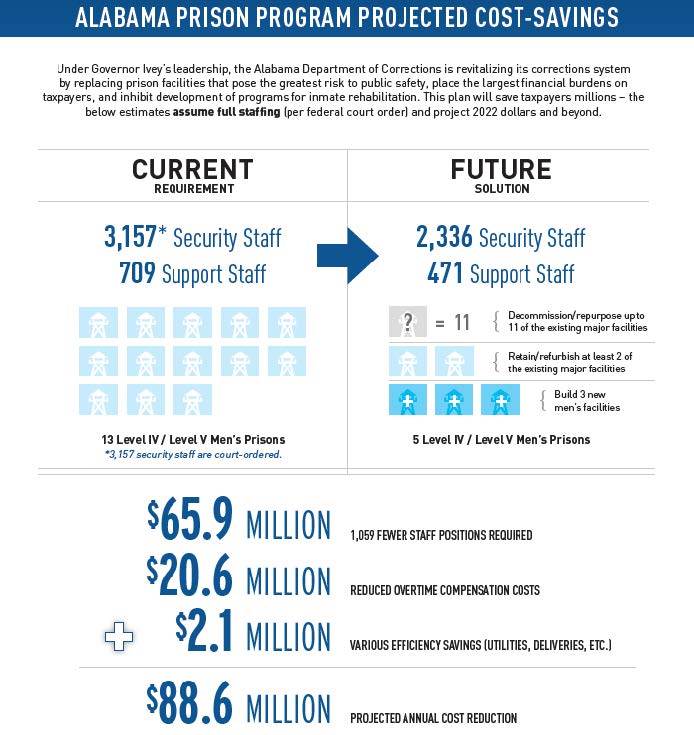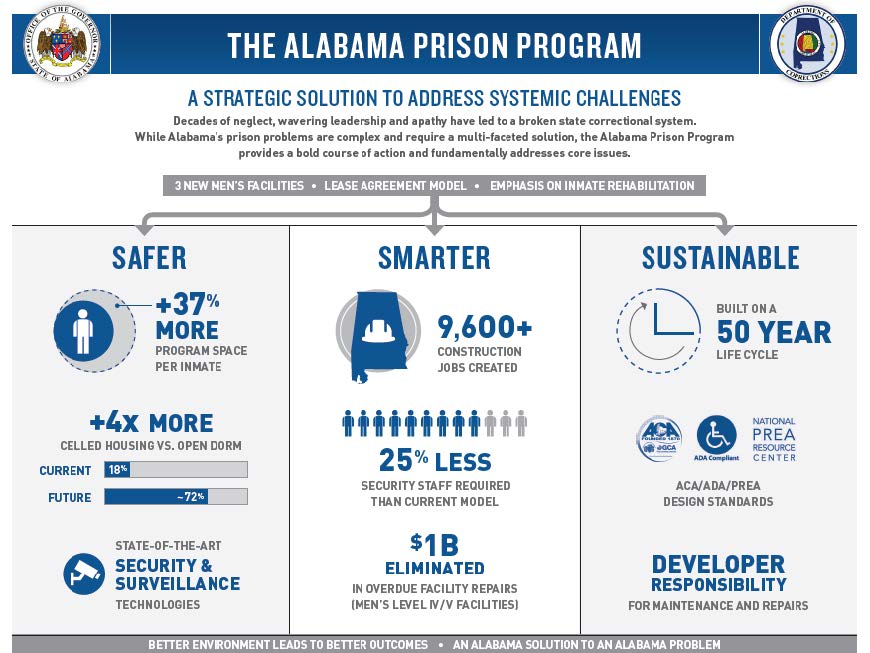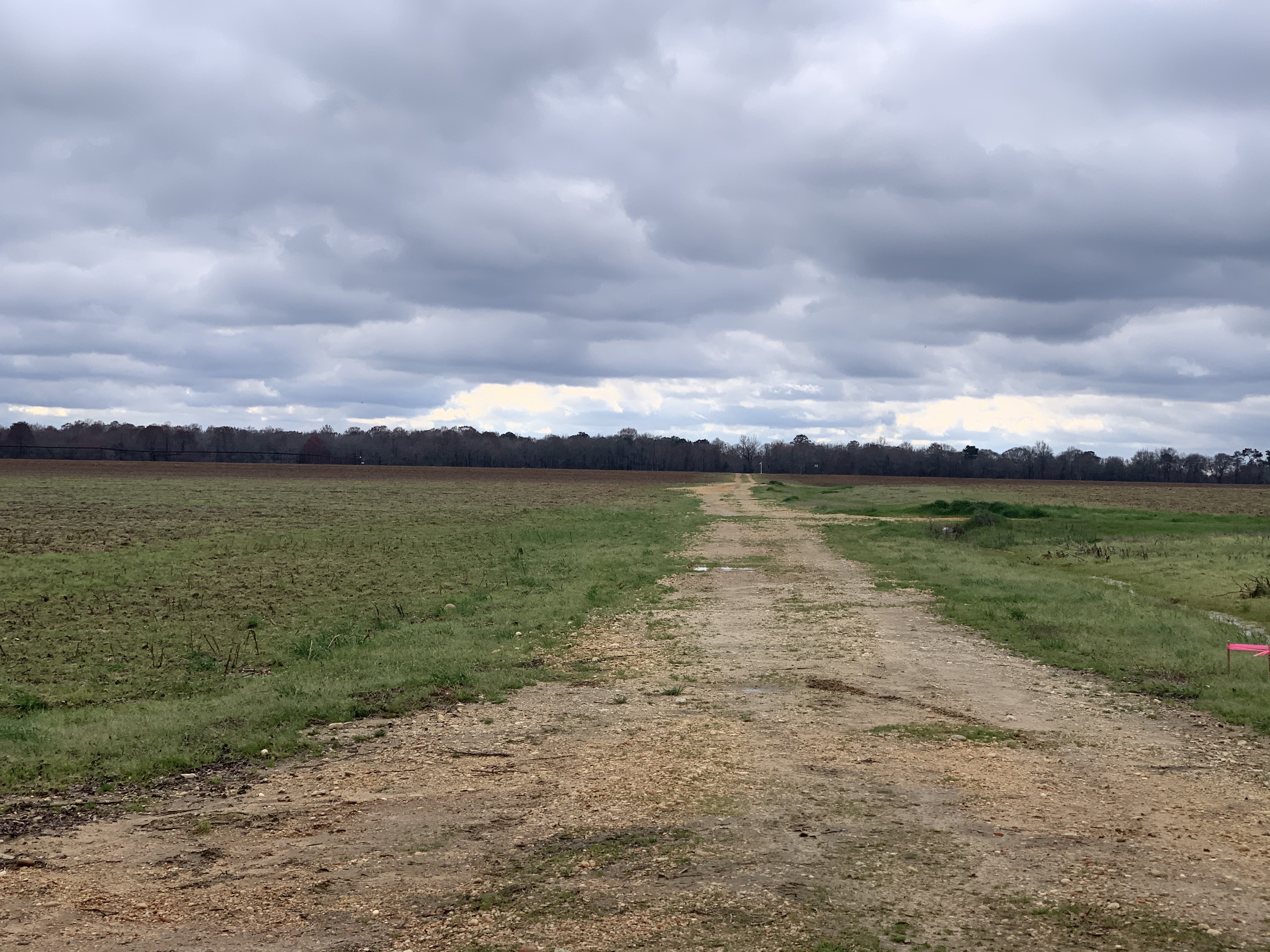Gov. Kay Ivey on Thursday announced the two developer teams that are to build the state’s three new mega prisons, and said those prisons are to be located in Bibb, Elmore County and Escambia counties.
But Ivey’s announcement left many important questions unanswered, and the details of what has been estimated to be more than $2 billion over the terms of the leases won’t be made publicly available until after the deals are signed with the Alabama Department of Corrections (ADOC). Ivey’s prison build plan now moves on to the lease negotiation phase.
The private prison company CoreCivic is to build and lease back to the state two of the three prisons, according to Ivey’s office; one in Elmore County, where several locations are under review, and the other to be located near Bell Fork Road in Escambia County.
APR reported in February that CoreCivic for more than two years had been eyeing land outside the city of Tallassee in Elmore county to build one of Alabama’s new prisons.
In addition to the 376 acres on Rifle Range Road in Elmore County, CoreCivic is also considering the location where Draper prison as a potential build site, sources who live in the area have told APR. Draper prison closed in 2016, but ADOC in April said the department made renovations to portions of the Draper building to house incoming inmates in quarantine during the COVID-19 pandemic.
The prison to be located near AL-139 and County Road CR-2 in Bibb County is to be built by a group called Alabama Prison Transformation Partners, made up of Star America, BL Harbert International, Butler-Cohen, Arrington Watkins Architects and Johnson Controls, Inc.
“The procurement process will now enter into a confidential negotiation period to ensure and secure the best possible value for the state,” according to a press release from Ivey’s office.
The Alabama Department of Corrections expects to close on those deals in late 2020, and the terms of the deal – which has been estimated at more than $2 billion, when including interest over the lease period – won’t be made publicly available until after the deals are signed.
Once those leases have run their course, the state won’t own the three prisons, ADOC Commissioner Jeff Dunn told state legislators in June. At the end of the leases, the state will have to renegotiate the terms, Dunn said then.

Previous plans by former Gov. Robert Bentley in 2016 and 2017, to build new prisons through issuance of bonds failed after state lawmakers couldn’t agree to vote the deals through. Ivey took up a similar plan, but by using a build-lease proposal the state Legislature is removed from the process of having to agree to fund the build.
Kansas officials used the same process that Ivey’s administration is moving forward with when that state entered into a build-lease contract with CoreCivic in 2018, to replace the state’s Lansing Correctional Facility.
The Kansas Department of Corrections estimated that building the new prison would save approximately $23 million over the 20-year lease, largely by cutting staffing in half by using newly designed cell blocks that don’t require as many officers to oversee inmates.
That projected savings didn’t come to be, however, when KDOC found the land unsuitable to the new design, and the savings was reduced from $23 million to just $1.3 million over 20 years, according to the state’s projected savings.
Kansas Gov. Laura Kelly told the Associated Press in February 2019 that the state was “hoodwinked” by CoreCivic into believing the new design would save the state millions.
“We were just, you know, hoodwinked, I think,” Kelly told the AP. She had been critical of the private prison proposal as a state senator before her governorship. “I was not.”
The Alabama Department of Corrections is to operate and staff the prisons, while the developer teams are to maintain them, according to Ivey’s plan.
“The Alabama Prison Program is vital for the long-term success of our state and communities. We all – legislators, advocates, and taxpayers, alike – can and should agree that we must rebuild Alabama’s correctional system from the ground up to improve safety for our state’s correctional staff and inmate population, and we must do it immediately,” Ivey said in a statement. “Given the failing state of the ADOC’s existing infrastructure and that the Department already is faced with more than $1 billion in deferred maintenance costs alone, pursuing new construction without raising taxes or incurring debt is the fiscally sound and responsible decision. I am pleased with the integrity of this procurement process thus far and look forward to continuing to work closely with the legislature as we comprehensively address this intricate and important issue that affects us all.”
ADOC has said that the state will be able to pay for the new prison leases through savings by offsetting the cost of repairing the state’s existing, dilapidated prisons, although the department has not released any breakdowns of those estimated savings or of expected staffing needs at the new prisons.
According to the press release from Ivey’s office on Thursday, Ivey will soon issue an executive order establishing the Alabama Prison Repurposing Commission, which will evaluate the state’s existing 13 prisons for men.

“The Commission will make recommendations as to which ADOC facilities should be retained and renovated as major correctional facilities, which could be renovated and repurposed for another use by the ADOC, and which should be repurposed to serve a different purpose, whether by another public entity or the private sector,” the release states.
The U.S. Department of Justice in July released a report detailing systemic problems of excessive use-of-force by guards in Alabama prisons, a failure to properly investigate the incidents and attempts by correctional officers and their supervisors to cover them up.
Severe overcrowding and understaffing contribute to the “patterns or practices of uses of excessive force,” the report states. Alabama’s 13 men’s prisons as of January held 6,000 more inmates than capacity allowed. Illicit drugs and other contraband in Alabama prisons have been a continuing problem, leading to more violence, sexual assaults and death, federal investigators found. If Alabama fails to satisfy the federal government’s concerns with 49 days of the release of the report, the government could sue, according to a letter from the Justice Department to Ivey.
Dunn has said that the new prisons alone won’t solve the overcrowding issue, and lawmakers have said Ivey isn’t likely to take up a special session to address the state’s prison crisis, leaving the fate of sentencing reform proposals floated by several lawmakers earlier this year uncertain.
Critics of Ivey’s plan to build new prisons say without broad changes in the culture of violence and corruption among prison staff, new facilities alone won’t solve the state’s crisis.
Alabamians for Fair Justice, a coalition of groups, advocates for incarcerated people and formerly incarcerated people, said in a statement following Ivey’s announcement Thursday that people in Alabama’s prisons are dying.
“They are dying at the hands of brutal and corrupt guards and leaders who have done little to address the culture of violence, medical neglect, and drug smuggling that ADOC staff engage in. They are dying from COVID-19. They are dying as a result of inadequate health care. They are dying because of inhumane conditions. They are dying from corruption that allows drugs to flood the prisons. And people will continue to die if the only action officials take is building more prisons,” the group’s statement reads.
“If Alabama truly wants to address the prison crisis, lawmakers must pass sentencing reforms like abolishing the Habitual Felony Offender Act and making the 2013 Sentencing Guidelines retroactive; investing in prison alternatives and community resources such as diversion programs, mental health treatment, and drug treatment; requiring the parole board to release more people; and creating a diverse and inclusive oversight committee to hold prison officials accountable for working to end the abuse of incarcerated people by ADOC correctional officers.
“The U.S. Department of Justice has already told us twice that brick and mortar is not the answer to the conditions that the DOJ found ‘routinely violate the constitutional rights of prisoners.’ Data-driven, humane policy solutions are needed now. It is time for the State of Alabama to put people over political interests and corporate profits.”



















































